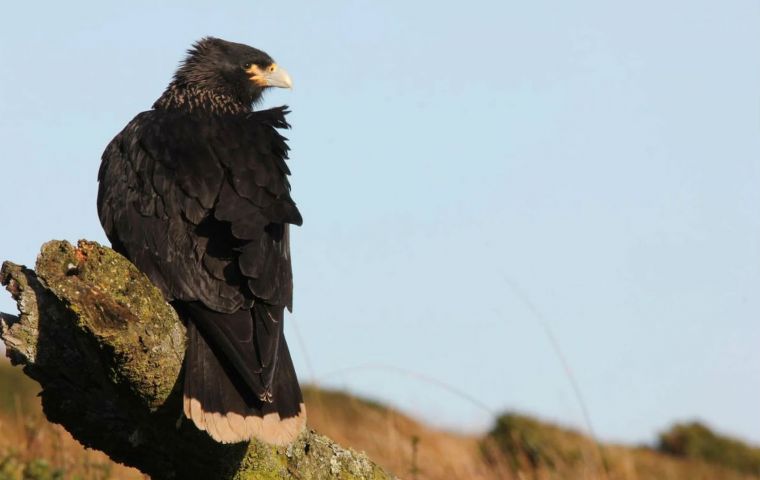MercoPress. South Atlantic News Agency
Johnny rooks threatened in Argentine islands by deer and goats
 The prey bird, carancho austral, or “Phalcoboenus australis”, can be found in the southern islands of Argentina and Chile and the Falkland Islands
The prey bird, carancho austral, or “Phalcoboenus australis”, can be found in the southern islands of Argentina and Chile and the Falkland Islands Argentine scientists from the Austral Scientific Research Center (CADIC) in Ushuaia announced they have revealed the subsistence mystery of the striated Caracara prey bird, “carancho austral”, in the Isla de los Estados (*), during the winter months, which remained unknown until now.
The prey bird, striated Caracara or carancho austral, whose scientific denomination is “Phalcoboenus australis”, can be found in the southern islands of Argentina and Chile and the Falkland Islands, as well as the Isla de los Estados where the scientific project took place.
The species feeds on eggs and chicks from the 250,000 marine birds such as Gentoo penguins and cormorants, during their reproductive season, which extends from September to February.
However the big mystery consisted in knowing how these members of the falcon family survive the rest of the year, when marine birds return to their normal lives.
“Since the caranchos australes are scavengers we thought that during the rest of the year they could feed on deer and goats, common in Argentina and Chile, but our project showed that this is not the case, only occasionally”, according to Ulises Balza a biologist from CADIC
The research project, headed by biologist Andrea Raya Rey, and published recently in Ecology and Evolution, analyzed the feeding habits of these scavengers in the different times of the year, age and reproductive condition.
One of the main discoveries was that the caranchos australes have a survival mechanism which is based on scavenging on high tide dead animals, mussels and other kinds of mollusk. Besides their diet includes the excrement of marine fauna who rest on beaches during winter time.
“We followed the prey birds in winter months and we saw that they left the Franklin Bay, where marine birds nest, and then continue along the coast of the Isla de los Estados, without going inland territory”, explained Balza.
“Invasive species normally outstand because of their adverse effects for native species or the overall eco system, and thus the islands are particularly vulnerable to those effects. However frequently the exotic species incorporate the trophic networks and not always with negative effects for the native species”, added Balza.
However the research showed that only 5% of the caranchos australes diet in winter months came from that source, (deers and goats) and thus is not an important element for their subsistence“.
”A negative interaction prevails among these species, since deer and goats put pressure on the grassland diminishing available areas for the caraancho australes to nest“.
Given their reduced number and the fragility of the eco systems to which they are associated, ”it can't be discarded that the caranchos australes might disappear in some of these places, as in effect it has happened in certain islands of the Falklands”.
In evolution terms, it is known that the species was isolated during the latest glacier eras in the islands, mostly treeless, and that is why they nest in the ground, close to marine birds, which provide them with their feeding during summer months, concludes the brief report on the caranchos australes and the striated Caracaras better known as Johnny rook in the Falklands.
(*) The Isla de los Estados, (Staten Island in English from the Dutch Stateniland) is an Argentine island some 29 kilometers off the eastern extremity of the Argentine Tierra del Fuego, from which it is separated by the Le Maire Strait. It was named after the Netherlands States-General and its original name was identical to that of the New York Borough of Staten Island. The island is part of the Argentine province of Tierra del Fuego, and of the department and city of Ushuaia. It has been declared an “Ecological, Historic, and Tourist Provincial Reserve” (“Reserva provincial ecológica, histórica y turística”), with access limited to tours from Ushuaia.




Top Comments
Disclaimer & comment rulesCommenting for this story is now closed.
If you have a Facebook account, become a fan and comment on our Facebook Page!